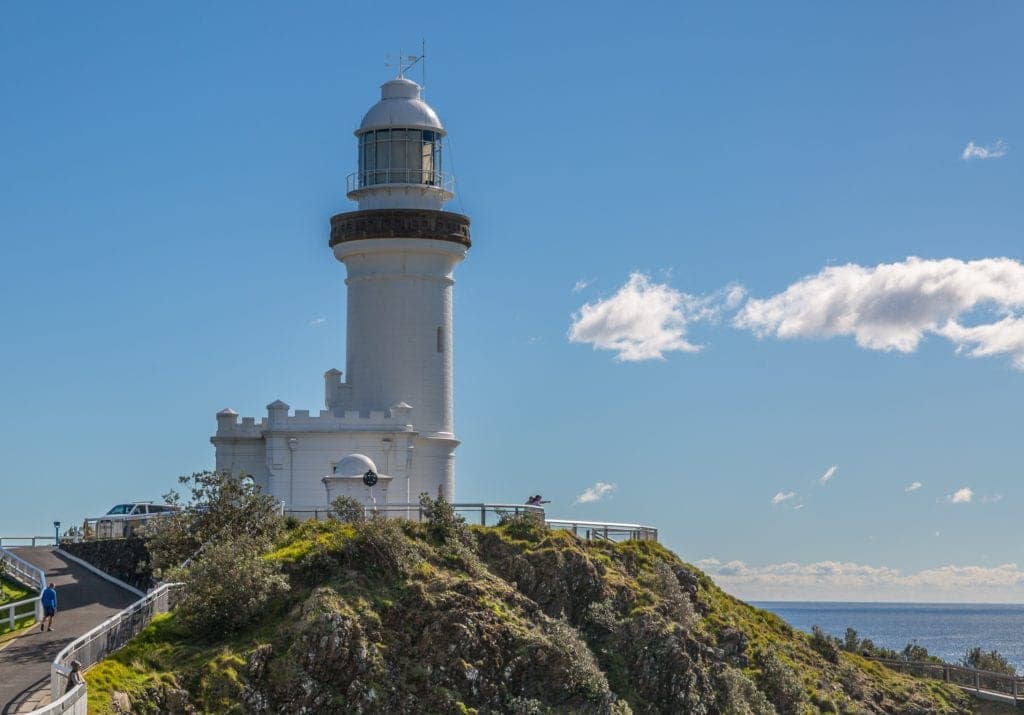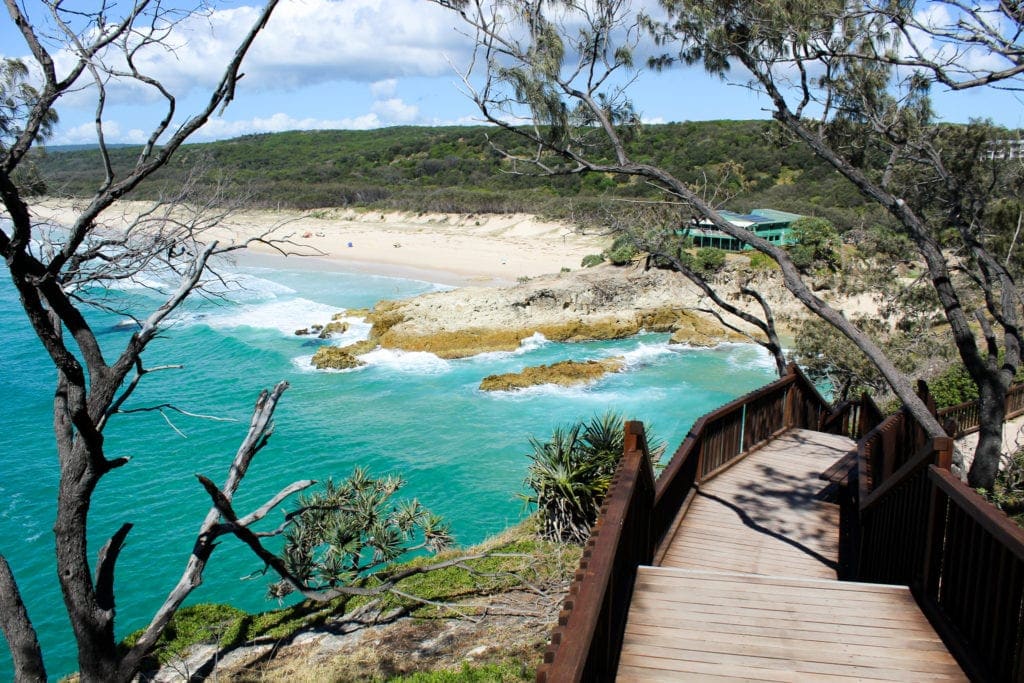One of the most exhilarating sights to behold on our coastline is the annual migration of the humpback whales. As the weather turns colder, the humpback whales leave their home in Antarctica and begin their journey north to warmer seas to calve before returning south again to show off their offspring. From May to October they can often be seen in local waters putting on a spectacular display of breaching, tale fluking and fin slapping, and it can be well worth a day trip to see! Here are some of our favourite places along the Humpback Highway for land based whale watching.
Land based whale watching
If you haven’t got the time or the sea-legs for a whale watching cruise we’ve found the best places to go land-based whale spotting, so grab your binoculars and camera, pack some snacks and the kids, and get ready to follow the whales north along the humpback highway.
Cape Byron – Byron Bay lighthouse

A great place to spend a whole day whale watching, with plenty of other things to do here too. Start by finding the Cape Byron Roving Ranger Cart (call 02 6620 9300 for location), which provides maps, reference books, and even a few whale bones to give the kids an insight before you begin your search. Then head up to the lighthouse for spectacular panoramic ocean views. You can grab a coffee and light meal from the café before starting the 3.7km loop walk around the headland for more viewing opportunities – and don’t forget to stop for picture at the most easterly point of the Australian mainland! On a winter walk around Cape Byron you won’t just see whales – look out for dolphins, monitor lizards and other wildlife too.
If you’re extending your stay in Byron Bay, we have lots of great ideas for things to with kids here.
Tumgun Lookout – Burleigh Heads National Park
Tumgun Lookout in the Burleigh Heads National Park is an elevated vantage point with great views to look down upon the whales. There are a couple of walking tracks under 3km that will take you to the lookout, and sheltered picnic areas, barbecues and toilets are all nearby. The walk to the lookout can be steep and tiring in places for younger children, but there are plenty of scenic and ocean views along the way to compensate those who can’t quite make it to the top.
Read our review of Burleigh Heads National Park here.
Gold Coast whale watching
If you’re lucky enough to have access to one of the high-rise buildings along the shore you are bound to spot whales, but even a stroll along The Spit should see you rewarded with more than a sighting or two. The Gold Coast is fairly central to the migratory route so it’s the perfect place to see whales for the whole of the whale watching season as whales heading north will often be passing whales returning south.
Here are more things to do on the Gold Coast with kids.
Point Lookout – North Stradbroke Island
North Stradbroke Island is the closest point to Brisbane for land-based whale watching. Catch the ferry from Cleveland and head to Point Lookout on the eastern side – the most easterly point in Queensland. From there the water is often clear enough to see not only whales, but dolphins, turtles and manta rays too. North Stradbroke Island is a great place to spend the whole day.
Cape Moreton – Moreton Island
Start your day trip with a ‘cruise’ across to the island aboard a comfortable ferry or catamaran, then head to Cape Moreton Lighthouse – the oldest lighthouse in Queensland – for a breathtaking coastal view. Looking down from the cliff, there is a good chance you will also see dugongs grazing in the sea grass below. Access to the lighthouse is only suited to 4WD and requires an uphill walk from the carpark. You will need a permit to take your own 4WD onto the island, but there are 4WD tour operators who will take you out in their vehicles to see all the sights of this beautiful island.
Cape Moreton Lighthouse is on the north side of Moreton Island, and it’s worth extending your visit with a stay at the Tangalooma Island Resort, which gives you the opportunity to feed the wild dolphins by hand and snorkel the famous Tangalooma Wrecks.
Point Perry – Coolum
You can drive right up to Point Perry Lookout or take a leisurely stroll up the hill from the Coolum surf club. This elevated lookout has picnic shelters, public toilets and a viewing platform, but it’s a very popular spot and can get busy.
Dolphin Point – Noosa Coastal Track
Dolphin Point is part of the Noosa Coastal Track, along a section of sealed pathway. Starting from the Noosa National Park entry on Park Road, the sealed path takes you 1.2km to Dolphin Point. The path is suitable for assisted wheelchair users though gradients can be steep in places, and there are toilet facilities along the way. Beyond Dolphin Point the path becomes gravel, but if you continue a further 1.5km you will reach Hell’s Gates where the ocean view is simply stunning. The great thing about Dolphin Point for families is that you can head down to the famous Hastings Street for welcome refreshments after your walk.
You can find lots more ways to keep the kids entertained in Noosa here.
Guaranteed whale sighting?
While we can’t guarantee that you will see whales on your land-based whale watching day trip, you can be assured of spectacular scenery, invigorating sea air, and other wildlife to assure a great day out.
For a guaranteed up-close whale watching experience we recommend taking one of the many organised boat tours available from various locations between the Sunshine Coast and the Gold Coast.
Whale watching tips
Wherever you choose for your whale watching experience follow these handy tips to be prepared:
- Choose a clear calm day when no rain is expected. Rain or heavy cloud will make it difficult to spot whales
- Get as high as you can for the best views, but with such expansive beaches and headlands along the Gold Coast, Sunshine Coast and larger bay islands you can spot whales from almost anywhere
- Take binoculars – the higher the power the better.
- Pack sunscreen and plenty of snacks and drinks
- Get comfortable – a whale can hold its breath for around 20 minutes before surfacing again and you don’t want to miss its play when it comes back up
Editor’s tip:
If you’re a super-organised parent try planning a game of whale-watch bingo in advance and give each child a score card of tale flukes, water spouting, breaching, calves spotted and other wildlife. The first to see gets the point, and the first to fill their card is the winner. Extra bonus points if you spot Migaloo – the famous WHITE humpback whale!
This article featured in Issue 34 of our printed magazine, published June 2019.






